 e-Manual e-Manual | Top Site map Site map Help Help |
|---|---|
 Category Top
Category Top What This Machine Can Do
What This Machine Can Do Overview of This Function
Overview of This Function Things You Must Do Before Using This Machine
Things You Must Do Before Using This Machine Flow of Sending Operations
Flow of Sending Operations Canceling a Job
Canceling a Job Specifying Destinations
Specifying Destinations Specifying Destinations Using the Address Book (Local)
Specifying Destinations Using the Address Book (Local) Specifying Destinations Using the Address Book (Remote)
Specifying Destinations Using the Address Book (Remote) Specifying Destinations Using the Address Book (LDAP Server)
Specifying Destinations Using the Address Book (LDAP Server) Specifying Destinations Using the One-Touch Buttons
Specifying Destinations Using the One-Touch Buttons Specifying a Destination by Entering an E-mail Address
Specifying a Destination by Entering an E-mail Address Specifying Destinations by Entering an I-Fax Address
Specifying Destinations by Entering an I-Fax Address Specifying a Destination by Entering a File Server
Specifying a Destination by Entering a File Server Specifying a File Server Using the Keyboard
Specifying a File Server Using the Keyboard Specifying a File Server Using the Browse Key (Windows (SMB))
Specifying a File Server Using the Browse Key (Windows (SMB)) Specifying a File Server Using the Search Host Key (Windows (SMB))
Specifying a File Server Using the Search Host Key (Windows (SMB)) Storing in a Mail Box
Storing in a Mail Box Setting Cc and Bcc Addresses
Setting Cc and Bcc Addresses Checking/Editing/Deleting the Information for a Destination
Checking/Editing/Deleting the Information for a Destination Favorite Settings
Favorite Settings Recalling Previous Send Jobs
Recalling Previous Send Jobs Storing New Addresses
Storing New Addresses Registering an E-Mail Address
Registering an E-Mail Address Registering an I-Fax Address
Registering an I-Fax Address Registering a File Server Address
Registering a File Server Address Registering a Group Address
Registering a Group Address Registering an Address Obtained via an LDAP Server
Registering an Address Obtained via an LDAP Server Storing/Editing/Deleting One-Touch Buttons
Storing/Editing/Deleting One-Touch Buttons Checking/Editing/Deleting a Stored Address
Checking/Editing/Deleting a Stored Address Registering/Editing/Deleting Favorite Settings
Registering/Editing/Deleting Favorite Settings Registering/Editing Favorite Settings
Registering/Editing Favorite Settings Checking Favorite Settings
Checking Favorite Settings Editing a Name/Comment
Editing a Name/Comment Deleting Favorite Settings
Deleting Favorite Settings Assigning Shortcuts
Assigning Shortcuts Switching the Color Mode
Switching the Color Mode Setting the Resolution
Setting the Resolution Specifying/Registering Scan Sizes
Specifying/Registering Scan Sizes Setting the File Format
Setting the File Format Trace and Smooth
Trace and Smooth Compact PDF or XPS
Compact PDF or XPS Limited Color PDF
Limited Color PDF Searchable PDF/XPS/OOXML
Searchable PDF/XPS/OOXML Adding a Digital Signature to a PDF or XPS
Adding a Digital Signature to a PDF or XPS Encrypting PDF Files
Encrypting PDF Files Applying a Policy
Applying a Policy Selecting the Original Type
Selecting the Original Type 2-Sided Original
2-Sided Original Book → 2 Pages
Book → 2 Pages Different Size Originals
Different Size Originals Adjusting Density Manually
Adjusting Density Manually Adjusting Background Density
Adjusting Background Density Adjusting the Image Sharpness
Adjusting the Image Sharpness Changing the Zoom Ratio
Changing the Zoom Ratio Erase Frame
Erase Frame Job Build
Job Build Delayed Send
Delayed Send Preview
Preview Job Done Notice
Job Done Notice File Name
File Name Subject/Message
Subject/Message Reply-to
Reply-to Setting E-Mail Priority
Setting E-Mail Priority Receiving I-Fax Documents
Receiving I-Fax Documents Processing Received Documents
Processing Received Documents Receiving Documents
Receiving Documents Setting the Memory Lock Mode
Setting the Memory Lock Mode Forwarding Received Documents
Forwarding Received Documents Available Paper Sizes
Available Paper Sizes When Problems Occur
When Problems Occur Questions & Answers
Questions & Answers|
IMPORTANT
|
|
The send settings for the last send job may be retained.
To cancel the settings, press
 (Reset). (Reset).The specified destinations are not retained.
|
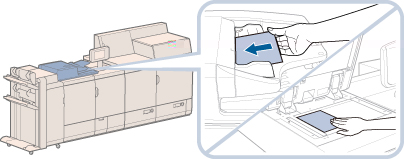
|
NOTE
|
|
For instructions on placing your originals, see "Placing Originals."
|
 (Main Menu) → [Scan and Send] .
(Main Menu) → [Scan and Send] .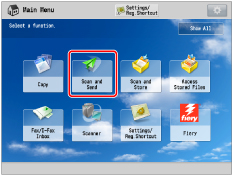
|
IMPORTANT
|
|
If you set an address type to 'On' in [Limit New Destination], you cannot enter new destinations of that type. Select a stored destination by using the Local Address Book, the Remote Address Book, LDAP Server in [Address Book], or pressing a one-touch button in [One-Touch]. (See "Restricting Sending to New Addresses.")
|
|
NOTE
|
|
You can specify and send to up to 256 destinations at the one time. If you specify a group address as a destination, each address stored in that group is counted as one destination.
The icons that are displayed on the screen are:
 : E-Mail : E-Mail : I-Fax : I-Fax : File : File : Group : Group : Mail Box : Mail Box : Bcc : Bcc : Cc : Cc |
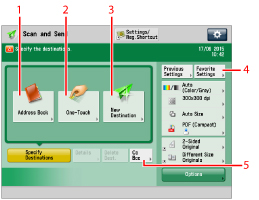
|
1
|
If you want to specify a destination stored in an Address Book
Refer to the following, depending on the type of address book.
|
|
2
|
If you want to specify a destination stored in a One-Touch button
|
|
3
|
If the destination you want to specify is not stored in an Address Book
Refer to the following detailed procedures, according to the address or server to specify.
|
|
4
|
If you want to specify a destination stored in Favorite Settings
|
|
5
|
If you want to specify Cc and/or Bcc addresses
|
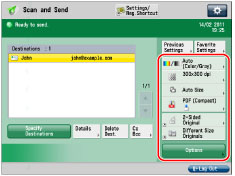
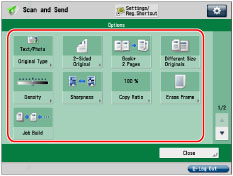
 or
or  to display the desired mode.
to display the desired mode. (Start).
(Start). (Start).
(Start). 
|
NOTE
|
|
The machine automatically detects the size of the original.
A screen to enter the user name and password may appear when you try to send to an e-mail or I-fax address, depending on the e-mail/I-fax settings. If the screen appears, enter the user name and password registered in SMTP Authentication. (See "Common Communication Settings for E-Mail/I-Fax.")
If you try to send to a file server in which [Confirm Before Sending] is set to 'On', a screen appears prompting you to enter a user name and password. In this case, enter the file server password. If you want to register a file server in a group address, set [Confirm Before Sending] to 'Off'. You cannot send to a group address including a file server in which the Enter Password Each Time setting is set to 'On'. (See "Registering a File Server Address.")
If you set the Preview mode to 'On', you can verify the images from the Preview screen before sending your document. (See "Preview.")
|
|
IMPORTANT
|
|
After a job is sent, the send settings may be retained except the specified destinations.
To cancel the settings, press
 (Reset). (Reset).To send other jobs with the same settings, specify destinations for the jobs as the destination specified for the previous job is not retained.
|
|
NOTE
|
|
We recommend you to read the following topics before using the Send function:
Main Power and Energy Saver key (See "Main Power and Energy Saver Key.")
Entering Characters from the Touch Panel Display (See "Entering Characters from the Touch Panel Display.")
Routine Maintenance (See "Routine Cleaning.")
You can print a report that contains the results of all send jobs. (See "Send TX Report" and "Communication Management Report.")
If you are using Department ID Management, enter the Department ID and PIN. (See "Entering the Department ID and PIN.")
The maximum number of send jobs that the machine can handle is 120. However, the actual number of send jobs that the machine can handle may be less than 120, depending on the following conditions:
When multiple documents are being sent at the same time
When large documents are being sent
When a large amount of memory is being used for the Mail Box and Fax/I-Fax Inbox
For instructions on canceling a send job, see "Canceling a Job."
You can also cancel a send job from the Status Monitor/Cancel screen. (See "Canceling a Job Being Sent or Waiting to Be Sent.")
|